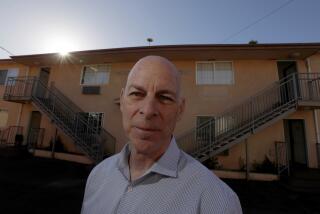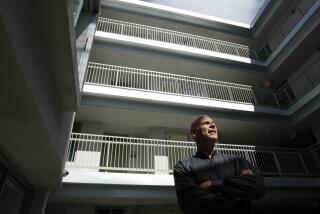A ‘Sure Thing’ Gone Awry
NEW ORLEANS — Anyone seeking to understand this city’s disastrous flirtation with casino gambling ought to start with the day property developer Christopher B. Hemmeter met Steve Rittvo on the top floor of a high-rise office building here and outlined his master plan to remake the New Orleans riverfront.
“I came away thinking that he’s got to be the most visionary guy I’ve ever met,” said Rittvo, a local real estate marketing expert, “or that this is a scam.”
Today, five years later, the only thing that’s crystal clear about the casino is that Hemmeter’s vision was seriously flawed. The question of whether it was a scam is still the subject of intense debate.
The centerpiece of his program, the world’s largest casino, sprawls shuttered and unfinished across a downtown square within walking distance of the fabled French Quarter. The enterprise is bankrupt, wiping out the interests of Hemmeter and several of his partners.
Although current plans call for another former partner, Harrah’s Entertainment Inc., to open the casino late next year, it will be more than a year behind schedule and about one-third the size originally envisioned. Additionally, the casino will probably produce a fraction of the $125 million in annual tax revenues once expected by the city and state.
“But we all knew this was rotten,” said City Councilwoman Peggy Wilson, a long-term opponent of the project.
“I’m trying to pretend that this era of my life is an era gone by,” Hemmeter said in a brief interview from his home in Bel-Air. “It was a very unfortunate experience.”
In an era when the gambling industry continues its campaign to expand into new venues across the country by portraying casinos as just another form of mass entertainment, the New Orleans story is a cautionary tale of how even a “sure thing” can go awry.
The project’s failure presents a special warning to other cities eyeing urban casinos as economic development tools.
These include Chicago, Atlanta, Philadelphia--and the Los Angeles area, where card clubs and the Hollywood Park racetrack have been lobbying for the right to offer slot machines and Las Vegas-style table games on their premises. So far their efforts have been stymied by the opposition of top elected officials and, in California, by the state’s economic recovery, which has diminished the government’s need for new sources of funds.
The New Orleans experience raises questions about whether gambling can profitably coexist with other forms of entertainment in urban settings, as opposed to the resort areas where it has traditionally thrived. A temporary casino designed to operate here during construction of the permanent structure was such a flop that Harrah’s shut it down after six months, throwing 3,000 employees out of work and precipitating the entire project’s bankruptcy.
Above all, it underscores the explosive mix that results when the casino industry injects into local politics vast quantities of its raw material: money. The corruption and financial disaster attending the project have been grist for anti-gambling activists nationwide, playing a role in a string of defeats for casino expansionists over the last three years.
“Louisiana’s bad example has virtually stymied the expansion of non-Indian gaming in other states,” said C.B. Forgotston, a prominent local casino opponent. “We turned into the casino industry’s worst nightmare.”
For their part, gambling industry spokespersons argue that the only thing the New Orleans story shows is that Louisiana is a very peculiar place to do business.
“There’s no national message here,” said Frank Fahrenkopf, head of the American Gaming Assn., the industry’s Washington lobbying arm. “This is a result of Louisiana going its own way.”
Two Firms Driven Into Bankruptcy
What is clear is that almost no one touched by the New Orleans casino came away unscathed.
Hemmeter’s investment in New Orleans drove two of his own development firms into bankruptcy. A third Hemmeter company, which holds virtually all that remains of a property and casino empire that once encompassed developments in Hawaii, California and Colorado, is in liquidation and the focus of an investigation by the Securities and Exchange Commission.
Harrah’s, which will be the largest owner of the casino company after its bankruptcy reorganization, will have to spend $75 million, on top of the $125 million it has already invested, to complete the building in time for the 1997 launch.
To win a local vote this fall over whether to allow the project to proceed, Harrah’s spent roughly $1 million to blanket the area with a relentless TV campaign touting its tax and employment benefits. That’s 10 times the sum ever spent on a local referendum in Louisiana history.
Millions of dollars seem to have vanished from the astronomical bankroll raised for the project from public and individual investors.
“More than $500 million went through the till and barely anything got spent building the casino,” said Thomas W. Tucker, a local lawyer and casino opponent. “Even the Louisiana Superdome only cost $100 million.”
State and federal investigations into graft and financial fraud are continuing. One local lawyer, a former Hemmeter partner, has already been indicted, and others are expected to follow.
Officials with Harrah’s are expressing regrets that the company ever accepted Hemmeter’s design for a casino nearly three times the size of what they believed the market could support.
“Shame on us that we agreed to do this,” Harrah’s Executive Vice President Colin Reed said in an interview from his Memphis, Tenn., office. “We squawked about [the size].” But under pressure from then-Gov. Edwin W. Edwards, Reed said, “We capitulated.”
Out-of-Towner Makes His Entry
Still, for all that this story may say about how business gets done in Louisiana, the debacle began with an out-of-towner.
Christopher Hemmeter first showed up here in 1991. He was smooth, voluble and grand, full of plans to redevelop a waterfront that lay underused after the failure of the 1984 World’s Fair.
People in the city had no idea what to make of him. Some called him a genius and some a flimflam man--and some called him both.
“At one time I thought he might be a front man for an FBI sting,” Forgotston said with a laugh.
Hemmeter had experienced one moment of national fame, when, in 1975, he presided over the dissolution of the World Football League as the upstart league’s chairman. Beyond that, he was known mostly in Hawaii, where he had erected a string of ostentatious resort hotels.
“It was all showmanship, panache, arrogance and flair,” said Ron Gilligan, head of R.F. Gilligan Realty, a Honolulu hotel and real estate firm. (By the mid-’90s Hemmeter’s grand resorts were almost all failing or in foreclosure, done in by a crash in the luxury tourism market.) While still riding high in Hawaii, Hemmeter had turned his sights on the casino business, opening some small-stakes halls in seasonal resorts in Colorado. New Orleans looked like a prime target for expansion. A lottery, riverboat gambling and video poker machines were already legal.
In 1992, Edwards, a devoted gambler, pushed through a bill legalizing one land-based casino for a site handpicked by the city of New Orleans: the Rivergate, an abandoned downtown convention hall in need of redevelopment.
The measure’s passage set off a free-for-all among casino developers vying for what appeared to be a monopoly franchise serving the entire Southeast. The excitement was so great it drowned out the handful of doubters wondering whether a world-scale casino was an appropriate addition to a city that was already one of the country’s premier tourist draws.
Market surveys, they noted, indicated that only a small percentage of the city’s 10 million tourists a year were likely to prefer gambling downtown to the traditional pleasures of strolling the French Quarter and dining out.
Even more damaging, the state and city imposed higher taxes on the casino than any other jurisdiction in the country--an annual nut of $100 million due the state and about $25 million for the city.
Still, others saw a great opportunity. Harrah’s coveted a New Orleans casino as the linchpin of its ambitious strategy to become a national brand name, the McDonald’s of casino gambling.
If a New Orleans casino worked, Harrah’s reasoned, it could replicate the formula nationwide. Harrah’s jumped into the fray with a proposal to build an 80,000-square-foot gaming hall for about $400 million.
Developer Enthralled Local Politicians
But they were outclassed by Hemmeter. The Hawaii developer entranced local politicians with his vision of New Orleans as a gambling mecca.
Instead of renovating the Rivergate (as Harrah’s proposed), Hemmeter would tear it down. In its place would go a brand new $850-million, 200,000-square-foot casino, twice the size of any other in the country.
“It was an outrageous, pompous, grandiose scheme,” said Wilson, the only local politician to vote against granting Hemmeter the Rivergate lease.
The plan would mean ripping up downtown streets. It would take a year longer than the Harrah’s casino to complete and raise the break-even point into the stratosphere.
But Hemmeter’s zeal rolled over the opposition. Local officials loved it for its grandeur, which promised twice as much opportunity for patronage as Harrah’s.
Hemmeter also liberally wined and dined politicos all over town. State investigative reports reviewed by The Times show he spent $50,000 flying 17 politicians and their families, including then-Mayor Sidney Barthelemy, to Hawaii. There were other trips, gifts and even jobs in the Hemmeter organization for politicians’ friends and relatives.
“I went over to Chris Hemmeter’s office one day and every time I opened a door there someone would scramble and hide under a desk,” said Wilson. “They were all relatives and friends of my colleagues on the council.” It was like turning on the light and seeing the cockroaches scurrying off.”
Therefore, no one was surprised when the city awarded Hemmeter the Rivergate lease in April 1993. But he still had to acquire a gaming license from the state. And there he ran into a buzz saw.
“Any rational state would have combined the lease and licensing procedure,” said Timothy Ryan, dean of the University of New Orleans Business School. In bifurcating the process, he said, the state opened yet another doorway for corruption.
And Harrah’s, which had linked up with a group of well-connected local lawyers called the Jazzville Group, was still in the running.
Thus the battle for the license featured two contestants scratching for influence any way they could. Hemmeter’s development partner was Caesars World Inc., whose Lake Tahoe casino was a favorite haunt for Edwards.
Another partner was an Edwards crony, William C. “Billy” Broadhurst, a New Orleans lawyer previously famous for having chartered the yacht “Monkey Business” for a 1988 cruise with then-presidential candidate Gary Hart and Donna Rice. Broadhurst has since been indicted for allegedly taking kickbacks in a riverboat case.
But Jazzville also included many of Edwards’ closest pals. Among them was Wendell Gauthier, one of the top plaintiffs’ lawyers in the Southeast and a leading figure in a multimillion-dollar class-action suit against tobacco companies.
License Losers Cry Foul
The August 1993 licensing vote of the Louisiana Economic Development and Gaming Corp., or LEDGC, the state’s gaming licensing board, ended up a squeaker: a 5-4 split--in favor of Harrah’s/Jazzville.
Hemmeter and Caesars cried foul. They charged that LEDGC member James Vilas and Chairman Max Chastain had illicit meetings with Gauthier and that Vilas had been seen enjoying champagne and a hot-tub soak with a woman they identified as a Gauthier girlfriend. (LEDGC investigators requested permission to pursue the allegations; instead, the LEDGC board voted in a closed-door meeting to shut the investigation down.)
Vilas denied the allegations as “completely ludicrous and completely false.” He had never been to the woman’s apartment or shared her tub, he said. As for the licensing vote, he contended that Harrah’s won because its project was more rational than Hemmeter’s and its financial projections more believable.
But with Hemmeter/Caesars holding the lease and Harrah’s/Jazzville the license, the casino was stalemated--until Edwards called both sides to the governor’s mansion and bludgeoned them into making a deal in the space of two hours. The new arrangement merged the interests of Hemmeter, Harrah’s and Jazzville. Caesars, dumped from the project, later sued Hemmeter and settled for $5 million.
What no one realized then, however, was that Edwards’ shotgun marriage spelled big trouble for the project. The years of fruitless political maneuvering had given casinos in neighboring Mississippi time to reach critical mass. They were now siphoning off potential customers from Texas, Louisiana and Tennessee.
In this environment, industry observers believed that only a modestly scaled New Orleans project had a chance. But Harrah’s was yoked to Hemmeter’s grand scheme, which required building a temporary casino until the permanent site was completed.
Located in Rundown Area
The temporary site was woeful, an old city building located in a rundown section of town too far from the tourist center. Concierges and cab drivers alike advised tourists to steer clear.
After the hall opened in early 1995, the overall business was poor--about 30% of expectations. That left local residents as the major clientele and defeated the purpose of drawing outside dollars.
The whole project was jeopardized because Harrah’s was counting on earnings from the temporary casino to help finance construction at the Rivergate.
By summer 1995, rumors began circulating that Harrah’s was preparing to abandon New Orleans.
The company responded with a full-page newspaper ad on Nov. 12, 1995. Headlined: “Harrah’s New Orleans Is Here to Stay. Bet on It,” the ad called the rumors “malicious” and “irresponsible.” Nine days after the ad’s appearance, the project’s banks withdrew their $137-million line of credit--after Harrah’s tipped them off that it was considering closing the temporary site. Twenty-four hours later, the day before Thanksgiving and with almost no advance warning to the city or its employees, Harrah’s shut the temporary casino and placed the New Orleans project in bankruptcy.
“It’s unfortunate the advertisement was put in the paper,” conceded Reed, insisting that it was truthful at the time.
Harrah’s has since proposed a bankruptcy reorganization that would leave it with about 40% of the project. The owners of $437 million in bonds floated to finance the casino would get 50.1% (among the largest holders: Fidelity Investments, the mutual fund company). The Jazzville group would get about 4.5%, and Hemmeter 3.5%, which would largely go to satisfy his own creditors. Hemmeter would also get a 15-year “consulting” contract worth annually more than $180,000.
The company aims to finish a 40,000-square-foot casino on the permanent site by midyear. Harrah’s said that size is well below the threshold at which state law requires it to fork over the $100-million annual state tax. That would ensure the project’s profitability, if barely. State officials, however, have not yet said whether they agree with Harrah’s interpretation of the law.
If they do and Harrah’s gets its way, the city will finally get its land-based casino, although whether it will be the municipal boon many expected remains open to question.
“The economic development aspect of this project is a complete fraud,” Wilson said. “We’re not going to benefit as a city.”
More to Read
Inside the business of entertainment
The Wide Shot brings you news, analysis and insights on everything from streaming wars to production — and what it all means for the future.
You may occasionally receive promotional content from the Los Angeles Times.










